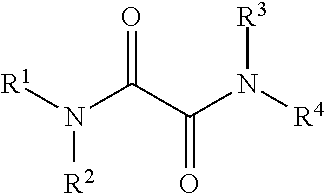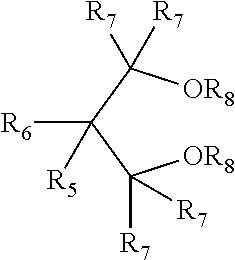Catalyst System for Olefin Polymerization and Method for Producing Olefin Polymer
a catalyst system and polymer technology, applied in the direction of organic compound/hydride/coordination complex catalyst, physical/chemical process catalyst, chemical apparatus and processes, etc., can solve the problem of limited expansion of phthalate free polypropylene production via diether compounds, and achieve enhanced stereo-selectivity, enhanced isotacticity, and activity.
- Summary
- Abstract
- Description
- Claims
- Application Information
AI Technical Summary
Benefits of technology
Problems solved by technology
Method used
Image
Examples
examples
[0036]In order to provide a better understanding of the foregoing, the following non-limiting examples are offered. Although the examples may be directed to specific embodiments, they are not to be viewed as limiting the invention in any specific respect. The activity values (AC) are based upon grams of polymer produced per gram of solid catalyst component used.
[0037]The following analytical methods are used to characterize the polymer.
[0038]Heptane Insolubles (% HI): The weight percent (wt %) of residuals of polypropylene sample after extracted with boiling heptane for 8 hours.
[0039]Melt flow rate (MI): ASTM D-1238, determined at 230° C. under the load of 2.16 kg.
[0040]Melt point (Tm): ASTM D-3417, determined by DSC (Manufacturer: TA Instrument, Inc; Model: DSC Q1000).
[0041]Determination of Isotactic Pentads Content: Place 400 mg of polymer sample into 10 mm NMR tube. 1.7 g TCE-d2 and 1.7 g o-DCB were added into the tube. 13C NMR spectra were acquired on a Bruker AVANCE 400 NMR (10...
examples 1-6
(A) The Preparation of a Solid Catalyst Component A1
[0047]To a three-neck 250 ml flask equipped with fritted filter disc, which is thoroughly purged with anhydrous nitrogen, 9.2 g of magnesium ethoxide, 0.22 g of N-ethyl-2,3-dioxopiperazine, and 80 ml of anhydrous toluene was introduced to form a suspension. 20 ml of TiCl4 was added through a stainless steel cannula. The temperature of the mixture was gradually raised to 90° C., and 8.5 mmol of 9,9-bis(methoxymethyl)fluorine was added. The temperature of the mixture was increased to 110° C., and maintained for 2 hours with stirring. The resulting solid was filtered and washed twice with 100 ml of anhydrous toluene at 90° C., and then 80 ml of fresh anhydrous toluene and 20 ml TiCl4 was added to the filtered solid. Temperature of the mixture was heated to 110° C., and stirred for 2 hours. The solid was filtered and residual solid was washed with heptane 7 times at 70° C. The final catalyst was collected and dried under vacuum to obta...
PUM
| Property | Measurement | Unit |
|---|---|---|
| Mass | aaaaa | aaaaa |
| Mass | aaaaa | aaaaa |
| Fraction | aaaaa | aaaaa |
Abstract
Description
Claims
Application Information
 Login to View More
Login to View More - R&D
- Intellectual Property
- Life Sciences
- Materials
- Tech Scout
- Unparalleled Data Quality
- Higher Quality Content
- 60% Fewer Hallucinations
Browse by: Latest US Patents, China's latest patents, Technical Efficacy Thesaurus, Application Domain, Technology Topic, Popular Technical Reports.
© 2025 PatSnap. All rights reserved.Legal|Privacy policy|Modern Slavery Act Transparency Statement|Sitemap|About US| Contact US: help@patsnap.com



